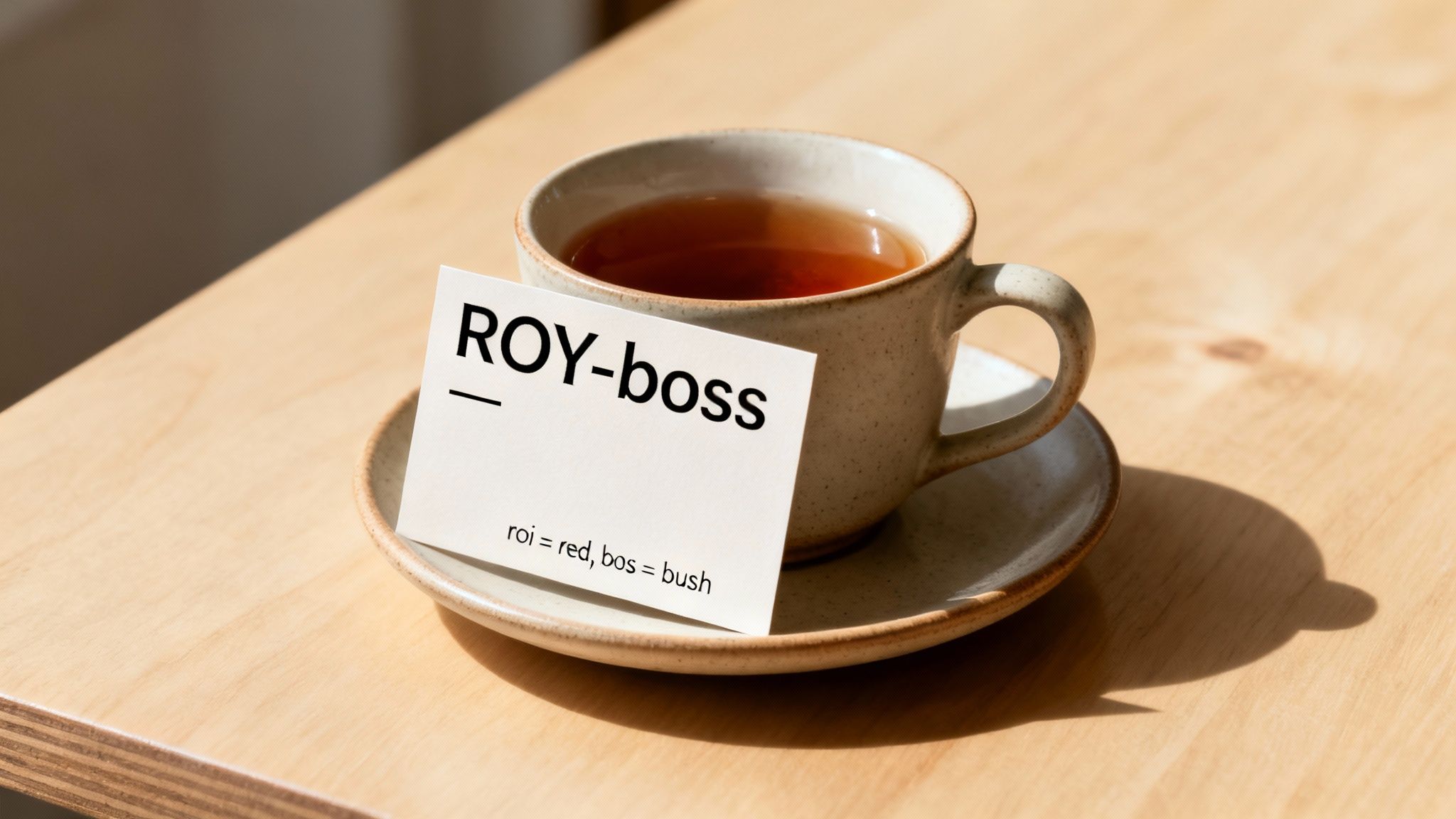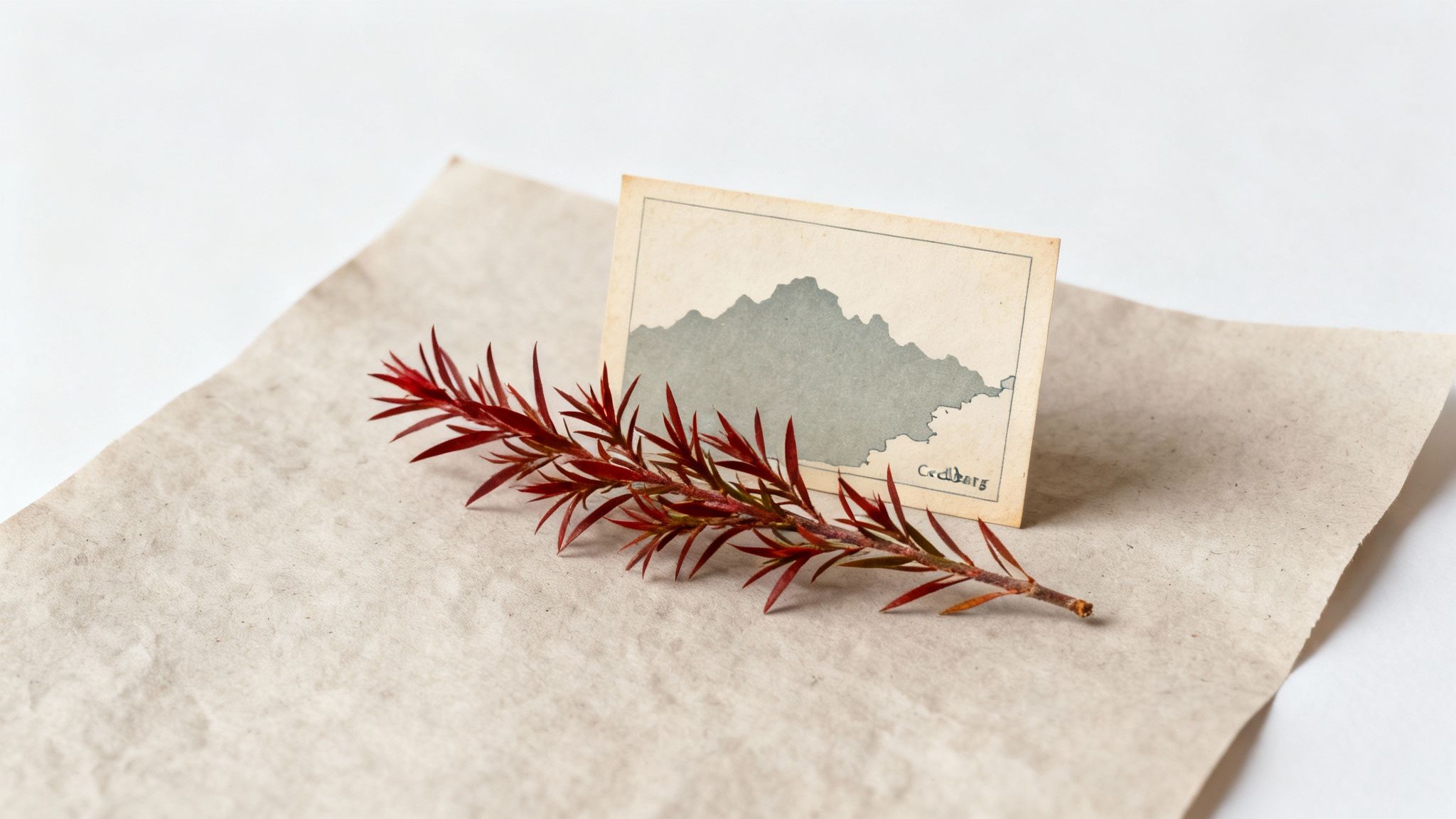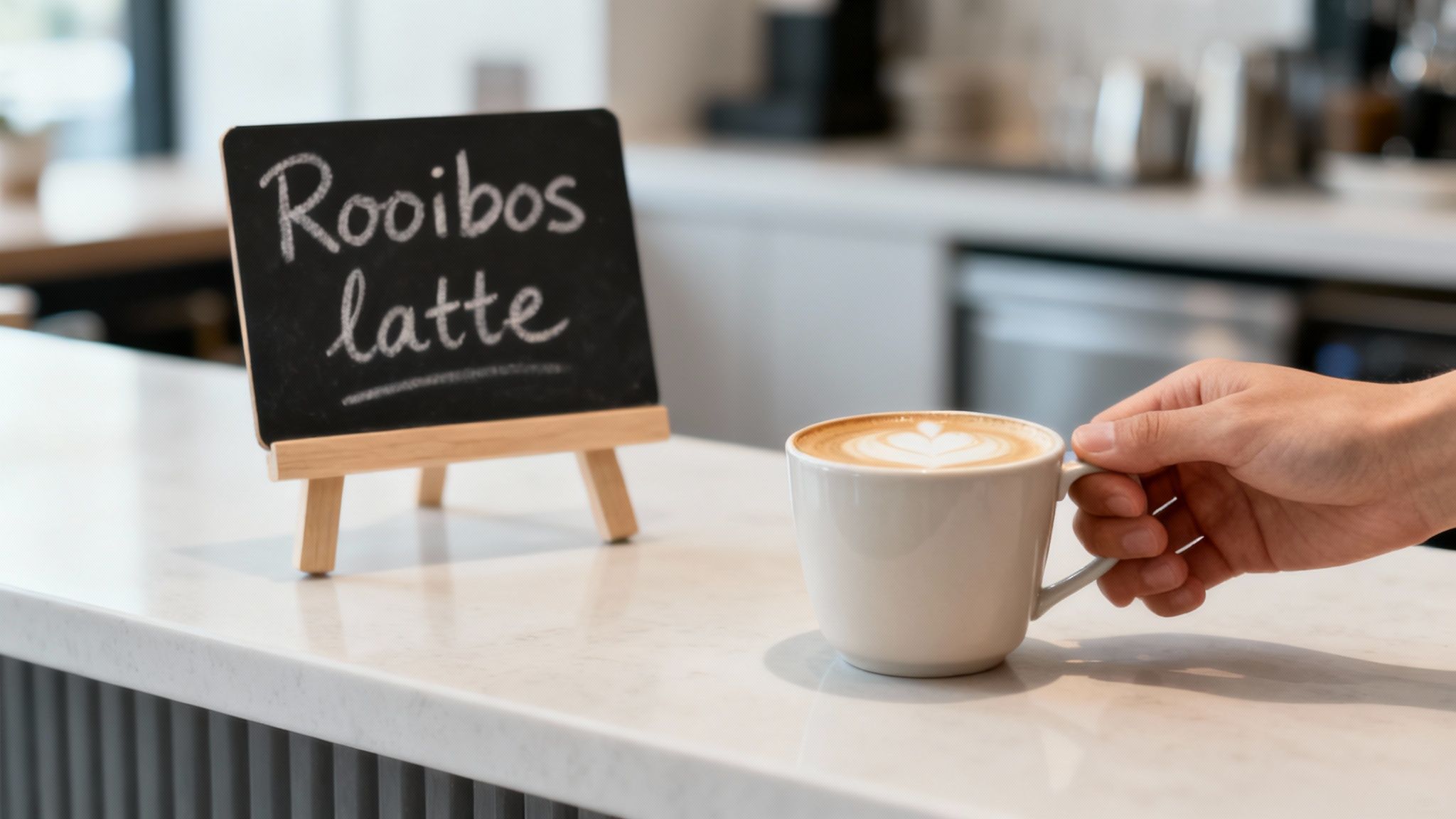Ever found yourself hesitating before ordering a rooibos tea? You're not alone. Its spelling can be a bit tricky for English speakers, but the correct pronunciation is actually quite straightforward: ROY-boss.
Once you know it, you’ll be ordering your favourite caffeine-free cuppa with total confidence.
Getting to Grips with Rooibos

The secret to saying ‘rooibos’ correctly is hidden in its origins. The name is pure Afrikaans, the language spoken in its native South Africa, where this unique plant has been enjoyed for centuries.
When you break it down, it's simple:
- ‘Rooi’ means ‘red’.
- ‘Bos’ means ‘bush’.
So, rooibos literally translates to "red bush," which perfectly describes the plant's appearance. Thinking of it this way often makes the pronunciation just click.
Let's break the sounds down even further.
Rooibos Pronunciation Breakdown
This simple table shows you exactly how each part of the word sounds in UK English.
| Syllable | Phonetic Sound (UK English) | Simple Explanation |
|---|---|---|
| Rooi- | /rɔɪ/ | Pronounced just like the name Roy. |
| -bos | /bɒs/ | Sounds exactly like the word boss. |
Putting those two sounds together gives you ROY-boss. It’s as easy as that.
As this delicious herbal tea has found its way into more UK cafes and supermarkets, more people are getting the hang of it. A 2022 report even showed that 3% of UK tea drinkers now prefer rooibos, making it one of the top herbal choices and cementing its place in the British tea scene.
If you'd like to learn more, you can read about its growing special status in the UK tea market. Now you can ask for it by name, appreciating not just its unique flavour but its rich heritage too.
Discover the Story Behind the Name

To really get why we say ‘rooibos’ the way we do, you have to travel (at least in your mind) to the Cederberg mountains of South Africa. It’s a stunning, rugged part of the world and, remarkably, the only place where the Aspalathus linearis plant—the source of all rooibos tea—actually grows.
That deep connection to its homeland is the secret to its pronunciation. The name isn’t English at all; it’s Afrikaans, a language with Dutch origins spoken widely across South Africa.
From Indigenous Roots to a Global Name
Long before it found its way into our teacups here in the UK, the local Khoisan people were harvesting the wild plant for its medicinal qualities. Much later, Dutch settlers in the region noticed its fine, needle-like leaves, which turn a deep reddish-brown as they ferment.
They gave it the name 'rooibos', which literally means 'red bush'. This is exactly why simply trying to sound it out with English rules doesn’t quite land. The name is a pure description of how the plant looks and a nod to its South African heritage.
Knowing the story behind 'rooibos' turns a simple brew into something more—a connection to a unique place and its cultural traditions. Saying it correctly is a small way to honour that history.
This is what sets it apart. While there are countless types of tea from every corner of the globe, rooibos has a story you can taste. Every sip carries a little piece of the Cederberg mountains, passed down through generations.
Common Pronunciation Mistakes to Avoid

Don't worry, it’s completely normal to stumble over a new word, especially when it comes from another language. When it comes to rooibos, most of us instinctively try to say it like an English word, which is where a few common trip-ups happen. Let’s walk through them so you can order your next cup with total confidence.
The most common mistake I hear is ‘ROO-ee-bus’ or sometimes ‘ROO-ee-boss’. It’s an easy trap to fall into; the double ‘o’ in English often sounds like the ‘oo’ in ‘food’, but since rooibos is an Afrikaans word, it plays by a different set of rules.
Another one is adding the word ‘tea’ at the end, as in ‘ROY-boss-tea’. While the first part is spot on, the word ‘rooibos’ itself already refers to the tea, much like ‘chamomile’ or ‘peppermint’. Adding ‘tea’ is a bit like saying "chai tea" – a little redundant!
To help you get a feel for how these mispronunciations stack up against the real thing, I've put together a quick comparison table.
Common Mispronunciations vs The Correct Way
| Common Mistake | Why It's Incorrect | How to Say It Correctly |
|---|---|---|
| ROO-ee-bus | Applies English 'oo' sound instead of the Afrikaans 'ooi' dipthong. | ROY-boss. Think of the name ‘Roy’. |
| ROY-boss-tea | The word 'tea' is redundant. Rooibos is the tea. | Just ROY-boss is all you need. |
| ROO-boys | Mixes the 'oo' sound with an English 'boys' sound at the end. | The second syllable sounds like the word boss. |
Seeing the common errors side-by-side really helps to cement the correct pronunciation in your mind.
A Few Tips for Self-Correction
To really lock in the correct sound, try connecting it to a word you already know.
- For the first syllable, just think of the name ‘Roy’. It’s exactly the same sound.
- For the second part, simply say the word ‘boss’. Easy.
The real key is remembering its origin. The word comes from two Afrikaans words: 'rooi' (meaning red) and 'bos' (meaning bush). Put them together, and you get ‘ROY-boss’. Thinking of it this way honours its South African roots and helps the pronunciation stick.
Say it out loud a few times. It might feel a bit strange at first, but with a little practice, it’ll soon feel completely natural.
Putting It All Into Practice

Alright, so you know how to say it. But the real test is using it out in the wild, right? Moving from theory to practice is easier than you think. It's all about having a few phrases up your sleeve so you don't freeze when it's your turn to order.
Imagine walking into your favourite cafe. Instead of pointing shyly at the menu, you can just confidently ask, “Could I get a rooibos latte, please?” Simple.
This isn’t just for cafes, either. You could be browsing the tea aisle in a shop and ask, “Excuse me, where can I find the herbal teas? I’m looking for rooibos.” It feels good to say it correctly and get exactly what you’re after.
Weaving It Into Your Vocabulary
The trick is to start treating ‘rooibos’ like any other tea in your vocabulary. A great way to practise is by chatting about it with a friend.
Here are a few ways you might bring it up:
- “I’ve started drinking rooibos in the evenings because it’s naturally caffeine-free.”
- “Have you tried vanilla rooibos? The flavour is absolutely incredible.”
- “I’m thinking of grabbing some loose-leaf African Rooibos to make at home.”
Every time you use the word, you’re building a bit of muscle memory. The more you say it aloud, the more natural it becomes. Soon enough, you won't even have to think about it.
Before you know it, ordering a rooibos will feel as normal as asking for an English Breakfast. It’s all just a matter of practice.
Why Bother Saying Rooibos Properly?
It might seem like a small thing, but getting the name ‘rooibos’ right is about more than just pronunciation—it’s a nod to its South African roots. The name is intrinsically linked to its heritage, and saying it correctly is a simple way to honour the tea’s origins and the people who first grew it.
Every time you order one, you’re connecting to the plant's unique journey from the Cederberg mountains all the way to your cup. With rooibos now a firm favourite here in the UK, making the effort to say it right shows you appreciate the story behind the brew, not just its lovely flavour.
It's a simple way to connect with the culture behind the cuppa. Taking a moment to say ROY-boss correctly shows a deeper appreciation for this wonderful caffeine-free drink.
The UK's love for rooibos has grown massively. Between 2010 and 2015 alone, sales shot up by a reported 300%, cementing its place in British tea culture. You can find out more about how rooibos is disrupting the tea industry if you're curious.
More on Rooibos: What You Need to Know
Right, so you've mastered the pronunciation. But what else is there to know about this fantastic brew? Let's dive into a few other questions we hear all the time.
First up, the flavour. What does it actually taste like? Red rooibos has this wonderful, naturally sweet character with nutty and smooth notes. You might even pick up hints of vanilla or honey. It’s got an earthy quality but, crucially, none of the bitterness you can sometimes get with other teas. It’s just incredibly easy-drinking.
Then there’s the caffeine question. Good news here: rooibos is 100% naturally caffeine-free. This makes it a brilliant choice for an evening cuppa or for anyone simply looking to cut down on their caffeine. If you're on the hunt for more brews like this, you can explore our guide to caffeine-free herbal teas.
Is Rooibos Good for You?
In a word, yes. It's brimming with antioxidants and electrolytes, which are great for helping your body stay balanced and hydrated. Some people even find it helps soothe inflammation.
As it comes from a plant, rooibos fits perfectly into all sorts of healthy lifestyles. If you're curious to learn more about that, this piece on understanding a plant-based diet has some really useful insights.
At its heart, rooibos is far more than just a tasty alternative to your usual tea. It’s a naturally sweet, caffeine-free infusion with a rich flavour and some impressive health credentials, making it a standout choice any time of day.
It’s also incredibly versatile. Enjoy it hot, poured over ice, or even made into a creamy rooibos latte.
At Jeeves & Jericho, we are passionate about bringing you the finest whole-leaf teas from around the world. Explore our collection to find your perfect brew.


